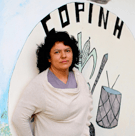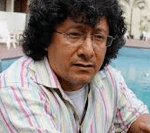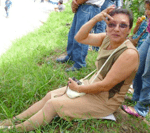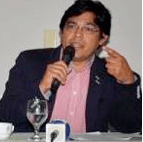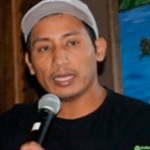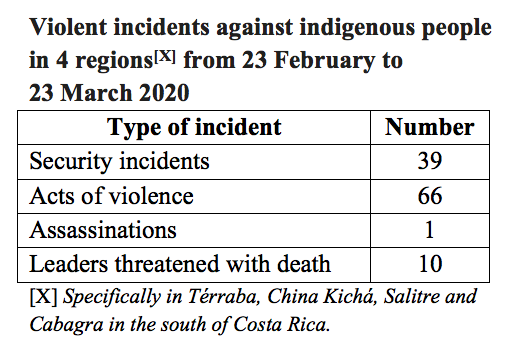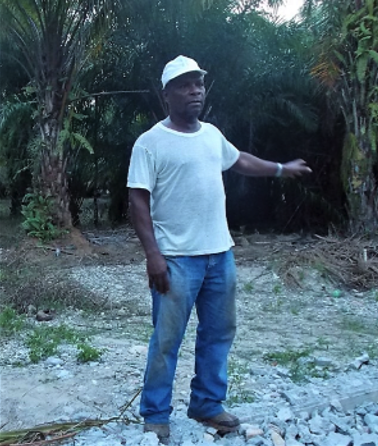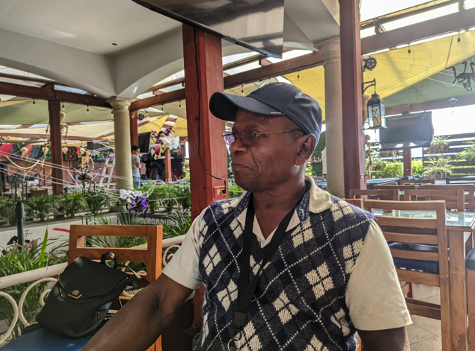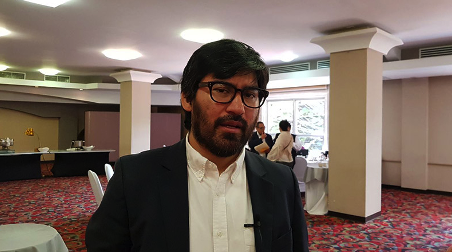The activist points out that development of hydroelectric megaprojects continues to aggravate climate change.
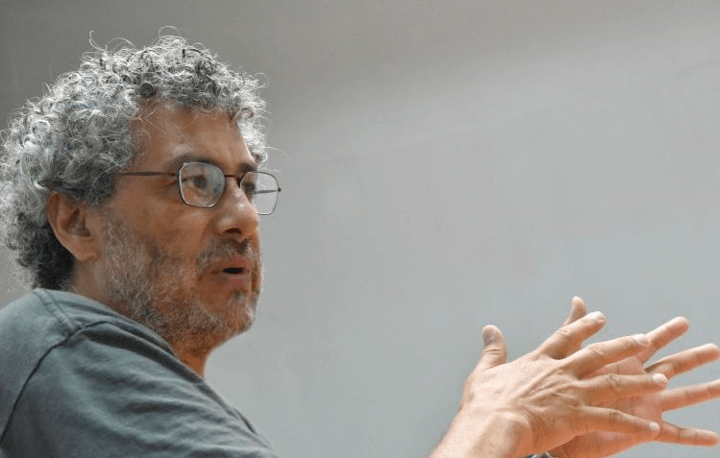
By Vinicio Chacón, Semanario Universidad (Costa Rica), vinicio.chacon@ucr.ac.cr
Sep 21st 2016. | Translated by Rick Blower
Key words: Berta Cáceres; COPINH; criminalization; hydro-electricity; climate change; Kyoto Protocol; free trade treaties.
The Mexican ecologist, Gustavo Castro, gained notoriety by being the sole witness to the assassination of Berta Caceres, the Honduran indigenous leader and environmentalist, on March 2nd [2016].
Castro is the leader of the organisation Other Worlds – Friends of the Earth and with calm but with forcefulness took on the Honduran judiciary, who, with incredible manipulation, sought to charge activists of the Civic Council of Popular Organisations and Indigenous Peoples of Honduras (COPINH) with the assassination.
From COPINH, Cáceres led the Lenca peoples’ fight against the Agua Zarca Hydroelectric Project (PH), a project of the company Desarrollos Energeticos S.A. (DESA).
In Costa Rica to participate in the II Latin American Congress on Environmental Conflicts (COLCA), Gustavo Castro spoke with Semanario Universidad in an interview coordinated through the Conservation Federation of Costa Rica (FECON).
What awakened your ecological conscience?
“It was a process of spending many years participating in co-operatives; I worked a lot with Guatemalan refugees who had come from the war. The jump to the fight for environmental causes came about in the nineties, when many investment projects came into the country after the North America Free Trade Agreement (NALCA), which obviously favoured the transnationals and the plunder of the country.
They were the country’s oil, gas, use of water, electricity, etc. It was not that there were no conflicts before, but when these pass into the hands of the corporations, they demand yet more favourable conditions for investment. They begin to modify the Water and the Mineral Laws, to hand over to the large mining companies the exploitation of gold, silver, strategic minerals of the country; now with the energy and also oil and gas reforms. This, in one way or another, begins to impact more and more on the environment, then begins a fight with more force about the defence of the territories; but also when we begin to see the deforestation that causes the infrastructure to favour the investments, not only in my case, but also in the peasant and indigenous communities you begin to have a greater awareness on the environmental impact.”
When did you begin to have contact with COPINH and Berta Caceres?
“I knew Berta in 1999, when we began to call for many processes of resistance, amongst them the creation of the Convergence of the Movement of the Peoples of the Americas, the Hemispheric Meeting against Militarisation, or the meeting against the Plan Puebla Panamá. We used to organise all of these meetings in Chiapas, later we repeated them in Honduras. A connection was made around the process of resistance in which we and COPINH not only took part but the whole region of Mesoamerica. There was much affinity in the process of putting together the movement with Berta and COPINH for more than 15 years.”
What is the most important lesson that you can take from the history of Berta Caceres?
“It is very difficult to name just one, because she was a very complex person, in the sense that she was very lovely, a very coherent person who had the capacity of structural analysis; also she could communicate strongly both with academics and members of congress, and at the same time she was involved in mobilization with the people.
“She was extremely respected and very tenacious, a very brave woman, always at the front of all COPINH demonstrations. Berta was very coherent in her analysis, her speeches and her attitude with the people and with the movement.
“With Berta’s assassination her personality was reborn on all fronts. As we say, Berta did not die, she multiplied, her presence is very strong.
“She was a happy person, she was very optimistic in spite of all of the adversity, even though she received many threats and assassination attempts.”
After the assassination was carried out and the hitmen took you for dead as well, what was the attitude of the authorities?
“I believe that what first took them by surprise was that there was a witness, they did not expect that. I arrived a day earlier at La Esperanza, (where Berta lived), so I think that only COPINH and Berta knew that I was going to be there. I believe that it was intended to be a ‘clean’ assassination, where Berta would be alone in her home. When they realised that there was a witness, they had to modify the scene of the crime and begin to make up a way to criminalize and implicate COPINH. They failed, so they begin to look at how to criminalize me.
“The authorities were unable to present to Berta’s family a credible version of events leading to the assassination, COPINH, the national community or the international community, when there was so much background information and the origin of the problem was very clear.
“For this reason they somehow tried to detain me in an illegal way in the country in order to find a way to impute me. In the end those who ended up being sacrificed are the manager of the company, the army and the hitmen. We know that they are not the only ones who are involved.
“The deal that they gave me was like a record card, as an object of proof, violating my human rights but also many judicial procedures. Everyone knows why, in the press, it emerged how the crime scene was altered. In those first days there were very many irregularities in the investigative process.”
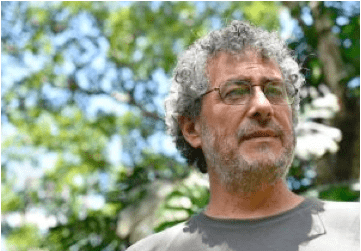 Even when they produced an artist’s impression, the artist drew another person.
Even when they produced an artist’s impression, the artist drew another person.
“I didn’t know that while I was in the Public Ministry, they had detained a member of COPINH on whom they were intent on placing the blame. Effectively, whilst I had not slept, was wounded, and with all this tension, they took me to the person who produced the ‘artist’ portrait. I told him that it was not like that, he erased the image and began to draw the same thing.
“They told me on various occasions that I could leave. I was obviously willing to help in all the proceedings, even though they had left me not having eaten, no sleep, without a blanket even if I had wanted one; anyway I went on supporting, left in my bloodied clothing. One way in which they tried to implicate me is that they stole my suitcase, which I left in Berta’s house, there was obviously the possibility to plant whatever thing which could implicate me – to date they have not returned it to me.
“They did not carry out any process of justice even though I appeared before the fiscal, the Public Ministry, the lawyer of the Honduran Commission of Human Rights, everyone is witness to me requesting a copy of my ministerial declaration, yet they wouldn’t let me have it – the copy of my declaration before the judge, and they did not give it to me; I asked that they return my suitcase, the same response. It was a total cynical violation of the Procedural Code, the Penal Code, and human rights.
“There wasn’t even a formality in the recognition of the faces. In the beginning they showed me photographs and videos of COPINH as if to say that the person responsible for the assassination was there.
“Many irregularities occurred in this process and so the government ruled that all of these ministerial formalities be kept secret.
“In the case of the state kidnapping at the airport, they took me back again for more meetings. Later, I stayed at the Mexican Embassy’s house for a month, up until the last day, without them giving an explanation as to why they wanted me, without even giving me a copy of the judge’s resolution which decreed the prohibition of my being allowed to leave the country, and before the insistence of the lawyer in the face of such judicial anomalies, such irregularity, the judge suspended the right of my lawyer to practice.”
Subsequently the authorities connected officials from the company DESA and the military institution with the murder, but you have said that it goes further?
“I did not say that, the press said it, COPINH said it, the family said it, there was even an attack against a journalist who explained a lot about the relationship and links between the judges and politicians in the problem.”
You have argued that to consider hydroelectric energy as clean is a ‘stupid idea’, which is a direct hook to the jaws of the proud Costa Ricans who produce energy in this way.
“It is not only Costa Rica, but the whole of Latin America, which for decades has always associated hydro electric as a clean development.
“If in Costa Rica they do not know it, they might know there is an impressive resistance in the whole of Latin America – the number of people who have been displaced and assassinated, who have not had an experience of adequate resettlement or redress. Even the same World Commission on Dams, which financed the World Bank, in the year 2000 published a report where they say that 60% of the basins in the world have been dammed, that 30% of fresh water fish have been killed as a result of the dams which generate 5% of greenhouse gases, that more than 50,000 large dams have been built in the world, that these countries remain extremely indebted to the World Bank, that 30% of the dams in the world have not generated the energy that they were meant to, that 80 million people have been displaced in the world at the same time flooding villages and towns. This is what the evidence tells us in the world, in all of Latin America, in Chile, Argentina, Colombia, Uruguay, Panamá and in Mexico there is resistance against the dams.
“Since this report the social movement against the dams said “we have to disarticulate that discourse”, a discourse in which hydro-electricity is the same as clean energy, when it has generated all these disasters, including the disappearance of mangrove swamps and whole basins as a result of the construction of dams.
“With the Kyoto Agreement they returned again with the intention to reposition the dams as a form of clean energy, in the sense that the countries of the North, in their attempt to reduce their output of greenhouse gases, are looking to replace it with an investment in clean energy. So, if I have to reduce 10 tons of CO2 from the Northern countries, I can’t do it; better I build a dam that according to me will eliminate these 10 tons, it can be saved with clean energy.
“The effects of the dams in the world are a disaster. So how do we generate another paradigm for clean energy? This is the big problem; but not building, blocking more basins, displacing more communities, that favours the construction companies of dams throughout the world. There are other ways and mechanisms to generate clean energy. Even in Europe and the United States they are dismantling dams. But if we have to build dams in the South with the idea that it is clean, sustainable and green energy, it is actually the dirtiest energy that has generated all these socio-environmental impacts.”
Is the ecological mentality and this new paradigm to produce energy that you mention losing the pulse against the ideology of extraction, of which the construction of dams is part?
“I believe rather that much of the resistance is strengthening. It has even managed to stop many hydro-electric projects in Brazil, Mexico and many other places.
“The big challenge that we have is how the same communities build alternative forms of development. I went to COPINH as a guest so that we could reflect on other models and mechanisms of generating clean energy, autonomous, community-led, serving the communities, not flooding the COPINH territories for special economic zones, for mining projects. For example, the leaching of gold can use, depending on the size of the mine, some 2 to 3 million tons of water every hour. They need dams and large quantities of energy.
“The use of energy and water is required for monoculture, for industrial parks, for model cities, even for large tourist centres, large hotels, for the automotive industry; and in the end, the people are those who pay the price of this so-called development.”
At what point in all of this process is it driven by Free Trade Agreements? Is it realistic to hope that these countries will denounce these agreements and make room for a new paradigm of energy generation?
“It is a challenge. The responsibility is not only for indigenous populations and peasants to be alert to and resist this. Certainly the commercial Free Trade Agreements accelerate this process and not only the agreements, but the so-called Kyoto Protocol too.
“The Free Trade Agreements open the doors to investments: if before there were not 10 industrial parks, now there are and they require water and energy; if before there was not a European, Japanese, North American automotive industry in our country, now there are 3, 4, 5, and they require water and large quantities of energy. If before there were no monoculture plantations and now there are, like Monsanto in zones which require large quantities of water, so now there are. If before there were no mining projects requiring large quantities of water and energy, today there are.
“Free Trade Agreements accelerate the need for water and energy, which is why they speed up investment in all of these types of mega-projects that require these inputs.”
Is the Paris Accord on the same lines as the Kyoto Protocol?
“Yes, at the end of the day they do not touch the root of the problem and they keep on seeing how to carry on giving excuses, as happened with the Kyoto Protocol: 15 years after its approval, after the urgency is announced, and they accept a reduction of 5% in greenhouse gases not after those 15 years, but 15 years further on – that is absurd.
“Then, that 5% I am not even going to reduce; I am going to look at how I can compensate for it. I continue producing tons of CO2, but I can buy the Costa Rican jungle, the environment services, which may breathe 10 tons. So the contamination balances out to zero: here I produce 10, there I breathe 10; I buy breath and we give carbon credits or elegantly a green economy.
“The same is happening in all of the Conferences of the Parties to the Framework Convention of the United Nations on Climate Change (COP) that there have been. It’s not been anything other than keeping on postponing and postponing without getting to the heart of the problem.”
What is at the heart of the problem?
“We have to change the paradigm of the system; we have to stop it at the source of climate change and that does not mean only this atrocious capitalism, but also the pollution generated by the most developed countries: between 60% and 66% of greenhouse gases that affect warming of the planet.
“We have to stop it and, as Berta said, there’s no time left. She said a lovely phrase: “wake up humanity”. I believe that the problem is systemic, it is planetary and we have to become aware of the necessity to change this paradigm of development.”
©2015 Semanario Universidad. Derechos reservados. Hecho por 5e Creative Labs, Two y Pandú y Semanario Universidad.
Reproduced here by kind permission of Vinicio Chacón.
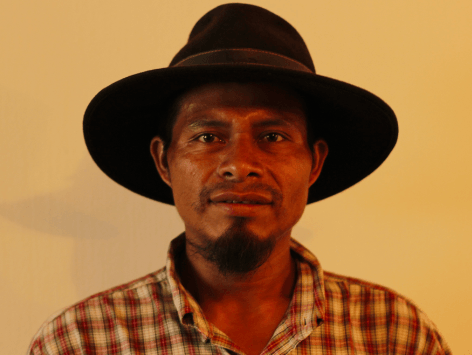 Domingo Vásquez, a Maya Ch’orti human rights defender from Guatemala, spent the first half of October on a Europe-wide speaker tour as a guest of Peace Brigades International (PBI). Domingo is a member of the Central Campesina Ch’orti ‘Nuevo Día’ (CCCND) and a member of the Indigenous Council of the Maya Ch’orti community of Pelillo Negro, Jocotán in Chiquimula department.
Domingo Vásquez, a Maya Ch’orti human rights defender from Guatemala, spent the first half of October on a Europe-wide speaker tour as a guest of Peace Brigades International (PBI). Domingo is a member of the Central Campesina Ch’orti ‘Nuevo Día’ (CCCND) and a member of the Indigenous Council of the Maya Ch’orti community of Pelillo Negro, Jocotán in Chiquimula department.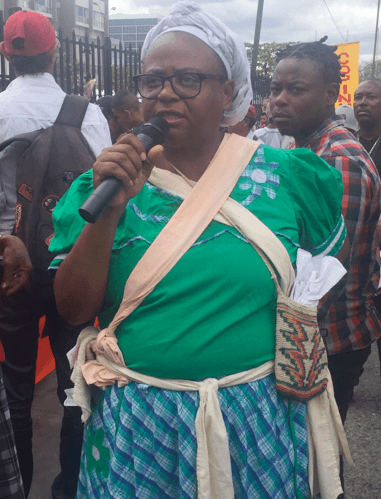
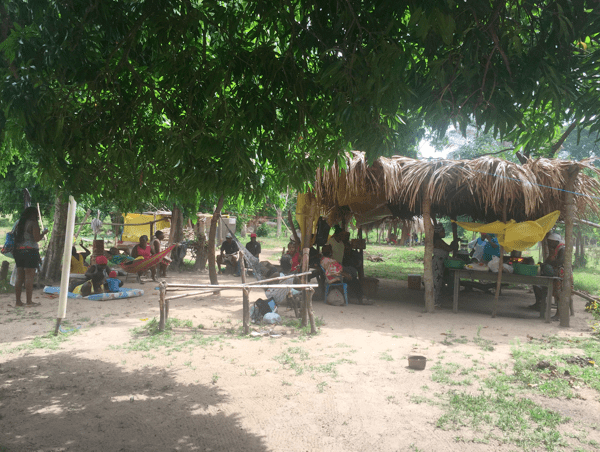
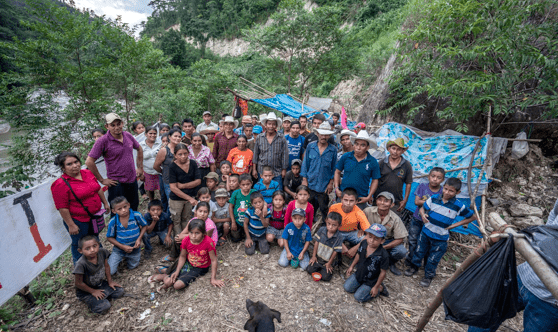

 Even when they produced an artist’s impression, the artist drew another person.
Even when they produced an artist’s impression, the artist drew another person.